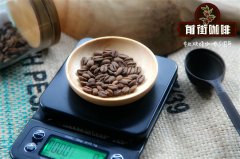Introduction of Elephant Bean / Kaddura Variety washed Coffee Bean in Pasco production area of Pasco District, Amazon, Peru

Professional coffee knowledge exchange more coffee bean information please follow the coffee workshop (Wechat official account cafe_style)
Peru Amazonas Rodriguez de Mendoza San Nicolas Maragogype y Caturra
Elephant beans / Kaddura washing of San Nicholas Peasants Association, Rodriguez Mendoza, Amazon, Peru
Country Peru (Peru)
Production area Pasco area (Pasco)
Osabomba Oxapampa
1700 meters above sea level
A variety of rose geisha (Geisha, Peru is known locally as Geysha)
Annual rainfall is about 1200mm
Treated water-washed scaffolding for sun drying
When it comes to Peruvian coffee, there are endless interesting stories, such as the ancient and mysterious Indian legends, the Sky City (Machu Pichu), the mysterious Nazca Land painting (Nazca Lines), the Andes Peak, the largest freshwater lake in South America, Lake Titicaca (Titicaca, which is almost as high as Yushan at 3812 meters). And don't forget that Peru is also the hometown of the llamas that Taiwan jokingly calls the grass-mud horse. Peru is such an interesting country, and in the boutique coffee industry, Peru is also one of the most interesting existence.
When it comes to Peruvian coffee, the most likely thing to associate with is organic certified coffee. Peru's organic coffee, in addition to the inherent human and natural conditions, the strong support of the government is also one of the important factors, almost can be said to be the most important producing area of the organic coffee market. But perhaps because of the deep impression of organic coffee engraving, the development of Peruvian boutique coffee is also easy to be overlooked. In fact, Peru can be said to have crazy boutique coffee production conditions, no kidding, it is really crazy.
Blessed by nature in the Andes, Peru is unique in its elevation and geomorphological diversity. Flying to the ancient capital Cusco, you can enjoy the snowy peaks of the Andes on the plane, but Lima, the capital, is an out-and-out coastal city an hour away. We went to the eastern producing areas of Peru, this time taking the night bus, leaving at 8 p.m., and arriving at around 9 o'clock the next morning. In a short period of 12 hours, it is an unforgettable experience to cross a mountain road about 5,000 meters above sea level and down to a producing area of about 2,000 meters above sea level. In Peru, it is not uncommon to plant 1800 or even 2000 meters above sea level. Coffee-producing families, mainly the Indian people who like to live in peace with nature, grow in the most natural way and retain the old trees of many tree species.
2017 is an important year for Peruvian boutique coffee, and the first COE was held for the first time in October 2017. it also marks that Peruvian coffee farmers have expanded their focus beyond organic coffee. The batch we selected this time was also grabbed through special channels during the COE competition.
This is the first time we have chosen beans from Peruvian coffee producing areas. Bring you three different flavors of high-quality coffee, noble not expensive, the quantity is very rare, very rare high-quality Peruvian boutique, do not miss it.
END
Important Notice :
前街咖啡 FrontStreet Coffee has moved to new addredd:
FrontStreet Coffee Address: 315,Donghua East Road,GuangZhou
Tel:020 38364473
- Prev

Peruvian Coffee YANESHA Yanisha Cooperative introduction _ Peruvian Alpine Coffee Taste description
Professional coffee knowledge exchange more coffee bean information please follow the coffee workshop (Wechat official account cafe_style) PERU CEPRO YANESHA Washed G1 level: G1 Origin: Villa Rica, Oxapampa varieties: Bourbon treatment: washing altitude: 1300-1700m Flavor description: honey apples, almonds, sweet taste, excellent mellow thickness and sour
- Next

Peruvian Pasco Vera Ricca Estate Rose Summer Coffee Beans_Peruvian Rose Summer Coffee Good to drink?
Professional coffee knowledge exchange More coffee bean information Please pay attention to coffee workshop (Weixin Official Accounts cafe_style) Peruvian coffee Pasco District Osa Pungba Province Vera Ricca Manor rose summer geisha washed dry fragrance delicate and elegant, with frangipani, blueberry, Earl Grey tea, lemon peel and other charming flavor. Frangipani, blueberry, peach, bergamot, lemon peel and coffee blossom bloom in the mouth
Related
- Detailed explanation of Jadeite planting Land in Panamanian Jadeite Manor introduction to the grading system of Jadeite competitive bidding, Red bid, Green bid and Rose Summer
- Story of Coffee planting in Brenka region of Costa Rica Stonehenge Manor anaerobic heavy honey treatment of flavor mouth
- What's on the barrel of Blue Mountain Coffee beans?
- Can American coffee also pull flowers? How to use hot American style to pull out a good-looking pattern?
- Can you make a cold extract with coffee beans? What is the right proportion for cold-extracted coffee formula?
- Indonesian PWN Gold Mandrine Coffee Origin Features Flavor How to Chong? Mandolin coffee is American.
- A brief introduction to the flavor characteristics of Brazilian yellow bourbon coffee beans
- What is the effect of different water quality on the flavor of cold-extracted coffee? What kind of water is best for brewing coffee?
- Why do you think of Rose Summer whenever you mention Panamanian coffee?
- Introduction to the characteristics of authentic blue mountain coffee bean producing areas? What is the CIB Coffee Authority in Jamaica?

